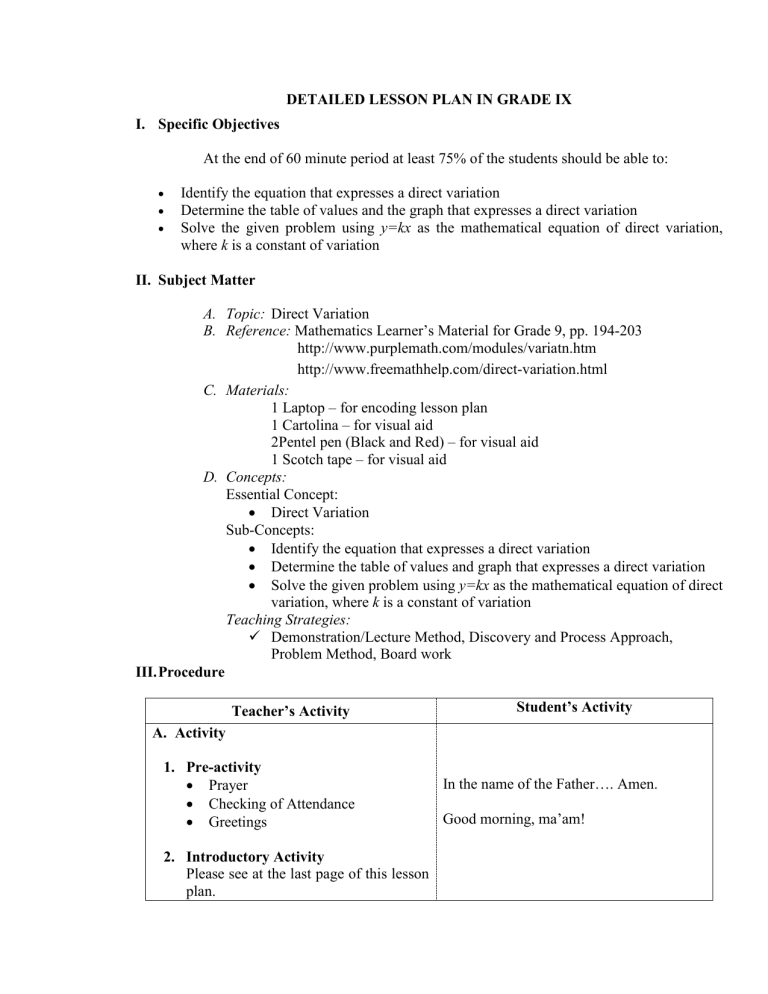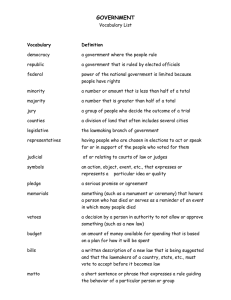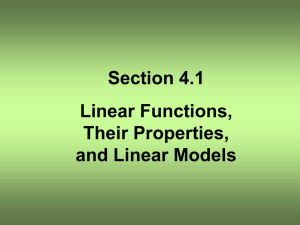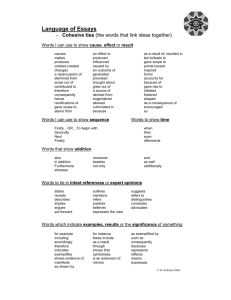
DETAILED LESSON PLAN IN GRADE IX I. Specific Objectives At the end of 60 minute period at least 75% of the students should be able to: Identify the equation that expresses a direct variation Determine the table of values and the graph that expresses a direct variation Solve the given problem using y=kx as the mathematical equation of direct variation, where k is a constant of variation II. Subject Matter A. Topic: Direct Variation B. Reference: Mathematics Learner’s Material for Grade 9, pp. 194-203 http://www.purplemath.com/modules/variatn.htm http://www.freemathhelp.com/direct-variation.html C. Materials: 1 Laptop – for encoding lesson plan 1 Cartolina – for visual aid 2Pentel pen (Black and Red) – for visual aid 1 Scotch tape – for visual aid D. Concepts: Essential Concept: Direct Variation Sub-Concepts: Identify the equation that expresses a direct variation Determine the table of values and graph that expresses a direct variation Solve the given problem using y=kx as the mathematical equation of direct variation, where k is a constant of variation Teaching Strategies: Demonstration/Lecture Method, Discovery and Process Approach, Problem Method, Board work III. Procedure Teacher’s Activity Student’s Activity A. Activity 1. Pre-activity Prayer Checking of Attendance Greetings 2. Introductory Activity Please see at the last page of this lesson plan. In the name of the Father…. Amen. Good morning, ma’am! 3. Lesson Proper The activity you’ve done is connected to the topic for today which is “Direct Variation”. Direct Variation – when a situation produces pairs of numbers in which their ratio is constant. The mathematical formula of Direct Variation, y=kx, where x - independent variable y – dependent variable k – constant of variation can be translated in mathematical statements; “y varies directly as x” “y is directly proportional to x” “y is proportional to x” For 2 quantities, x and y, an increase in x causes an increase in y as well. Similarly, a decrease in x causes a decrease in y. Suppose we have the equations, its table of values and graphs: y=4x x -2 -1 0 1 2 y -8 -4 0 4 8 x -2 -1 0 1 2 y 4 2 0 -2 4 y=-2x y=2x+3 x -2 -1 0 1 2 y -1 1 3 5 7 From the 3 equations which do you think is/are the example/s of a direct variation? Why? y=4x and y=-2x, because it’s in the form of y=kx, while y=2x+3 is not an example of direct variation. Correct! This is in the form of slopeintercept form y=mx+b, where m is the slope and b is the y-intercept. How about y=4x and y=-2x, is it in a form of slope-intercept form? Why? Yes. It is in the form of y=mx+b, but its yintercept/b is zero. Correct! Therefore, direct variation is simply in a slope-intercept form when b/yintercept is zero. So, in y=4x and y=-2x, their y=intercepts are zero and their slope are 4 and -2, similarly the slope determines the constant of variation. Do you get it? Yes! From the given 3 graphs, how do you determine if it expresses a direct variation? The graph should have the same slope and always crosses the origin (0,0) Correct! Graph of y=4x: Expresses Direct Variation Graph of y=-2: Expresses Direct Variation Graph of y=2x+3: Do not expresses Direct Variation From the given 3 table of values, how do you determine if it expresses a direct variation? Correct! But when the value of x is zero the value of y will always be zero and its ratio will always be zero. If you take a look in its graph, the graph of y=4 and y=-2 crosses the origin (0,0). Get the ratio of y and x in each column. If it is the same/equal then there is a constant of variation and the table of values express a direct variation. y=4x Get the ratio of y and x in each table of values to determine if it expresses a direct variation. x -2 -1 0 1 2 y -8 -4 0 4 8 R 4 4 0 4 4 As you can see the ratio is equal to the Expresses Direct Variation constant of variation. y=-2x x -2 -1 0 1 2 y 4 2 0 -2 4 R -2 -2 0 -2 -2 Expresses Direct Variation y=2x+3 x -2 -1 0 1 2 y -1 1 3 5 7 R -1/2 -1 ∞ 5 7/2 Do not expresses direct variation Now, how do you solve the given word problem which expresses a direct variation Example #1 If y varies directly as x and y=24 when x=6, find the variation constant and the equation of variation. Solution: Express “y varies directly as x” as y=kx Solve for k by substituting the given values in the equation. y = kx 24 = 6k k = 4 – constant of variation Substituting 4 to k in y=kx, y = 4x – equation of variation Example #2 The table below shows that the distance d varies directly as the time t. Find the constant of variation and the equation which describes the relation. Time (hr.) 1 2 3 4 5 Distance (km) 10 20 30 40 50 Solution: Since the distance d varies directly as the time t, then d=kt. Using one of the pairs of values, (2, 20), from the table, substitute the values of d and t in d=kt and solve for k. d = kt 20 = 2k k = 10 – constant of variation y = kt y = 10t – equation of the variation Example #3 If x varies directly as y and x=35 when y=7, what is the value of y when x=25? Solution: x = ky 35 = 7k k = 5 – constant of variation x = ky 25 = 5y y=5 Other solution by proportion, Since x/y is a constant, we write k=x/y, from here we can 𝑥 𝑥 obtain a proportion 𝑦1 = 𝑦2 . 1 2 x1 = 35 y1 = 7 x2 = 25 y2 = ? 𝑥1 𝑥2 = 𝑦1 𝑦2 35 25 = 7 𝑦2 35y2 = 175 y2 = 5 we obtain the same answer. Example #4 (Drill/Board work) I. In each of the following, y varies directly as x. Find the values as indicated. 1. Find the constant of a direct variation when x = 6 and y = -30. 2. If the constant variation is -4, then what is the value of y when x = -6? 3. If y=3 when x=15, find x when y = 5. 4. If y = -8 when x = -2, find x when y = 32. II. The distance traveled varies directly with the time of travel. If the distance traveled is 250 meters in 25 seconds, find the distance traveled in 60 seconds. k = -5 y = 24 k=1/5, x=25 k=4, x=8 d = kt 250 = 25k k = 10 d = kt d = 10y d = 10(60) d = 600 meters B. Abstraction How do you identify expresses direct variation? equation that C. Analysis How do you determine the table of values that expresses a direct variation? How do you determine the graph that expresses a direct variation? How do you solve the given word problem using y=kx as the mathematical equation of direct variation, where k is a constant of variation D. Application Bella uses 20 liters of gasoline to travel 200 km. How many liters of gasoline will be use on a trip of 700 km? IV. Evaluation / Assessment A. Find the constant of variation and write an equation where y varies directly as x. 1. y = 28 when x = 7 2. y = 30 when x = 8 B. In each of the following, y varies directly as x. Find the value as indicated. 3. If y = 36, when x = 4, find y when x = 7 4. If y = 10, when x = 2, find y when x = 3 C. The distance you travel varies directly with time. If you travel 147 miles in 3 hours, how long with it take to travel 245 miles? V. Assignment Activity 6, pp. 200-202, B(1-3, 7-8) and D(1-5). A. Determine if the table and graphs below express a direct variation between the variables. If they do, find the constant of variation and an equation that defines the relation. 1. x 1 2 3 4 y -3 -6 -9 -12 2. x 1 2 3 4 y 3 6 -9 -12 3. x 1 2 3 4 y -3 2 -4 5 4. 5. B. In each of the following, y varies directly as x. Find the values as indicated. 1. If y = 12 when x = 4, find y when x = 12 2. If y = -18 when x = 9, find y when x = 7 3. If y = -3 when x = -4, find x when y = 2 4. If y = 3 when x = 10, find x when y = 1.2 5. If y = 2.5 when x = .25, find y when x = .75 Group Activity (10 groups, good for 10 minutes) I. Direction: Complete the table of values using the formula of the perimeter of the square (P=4s) then graph the points from the table of values you’ve completed. P=4s Side of the square (cm) Perimeter of the square 1 2 3 4 5 6 7 Direction: Base from table of values and graph you’ve completed, answer the ff. questions. 1. What equation describes the graph? 2. What happened to the perimeter when the side is 2? 3? , 3. What happened to the perimeter of the square as the side of the square increases? 4. Find the ratio of the perimeter of the square and the side of the square. Side of the square (cm) Perimeter of the square 1 2 3 4 5 6 7 𝑃 Ratio ( 𝑆 ) 5. What have you observed about the ratios of perimeter of the square and the side of the square?



